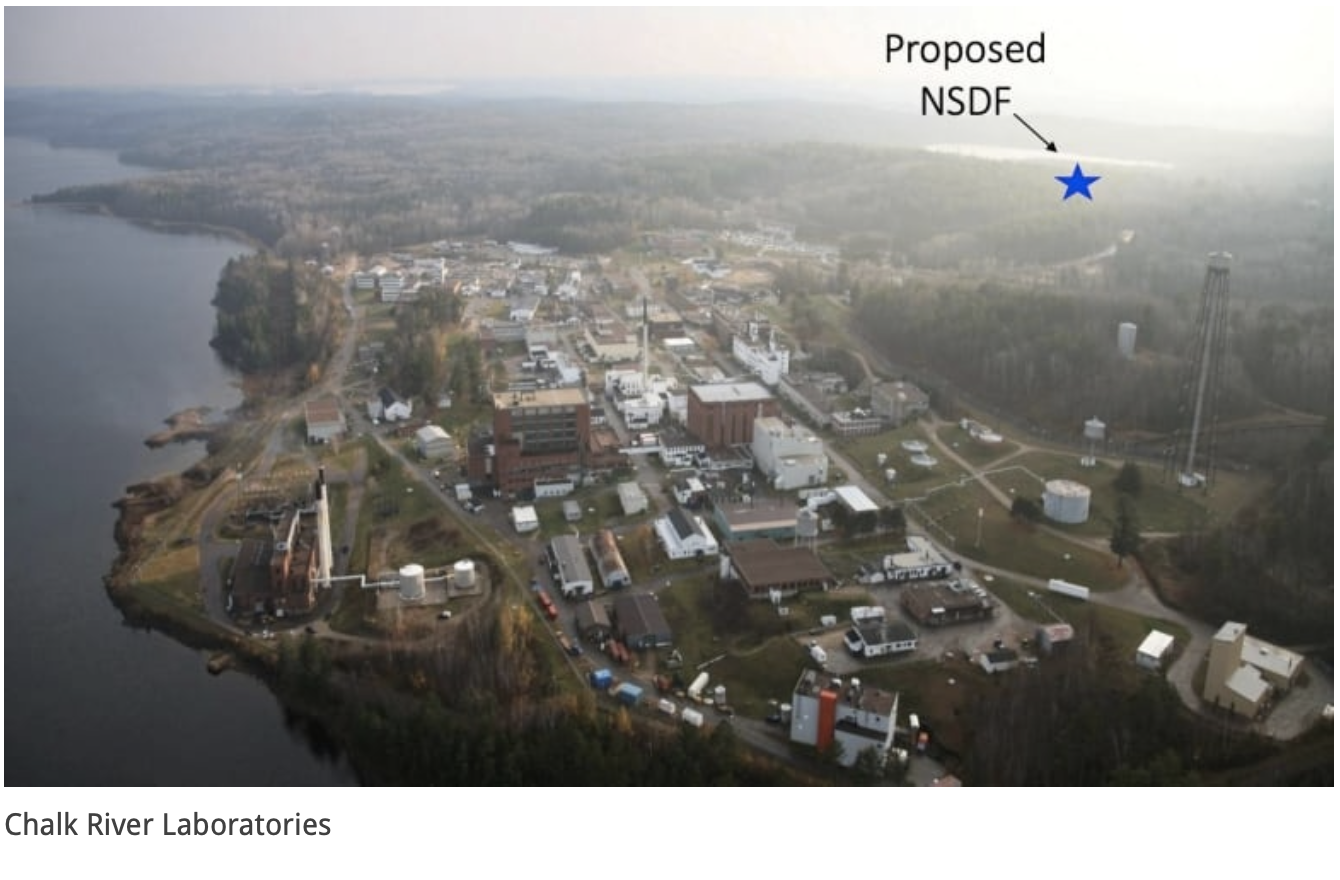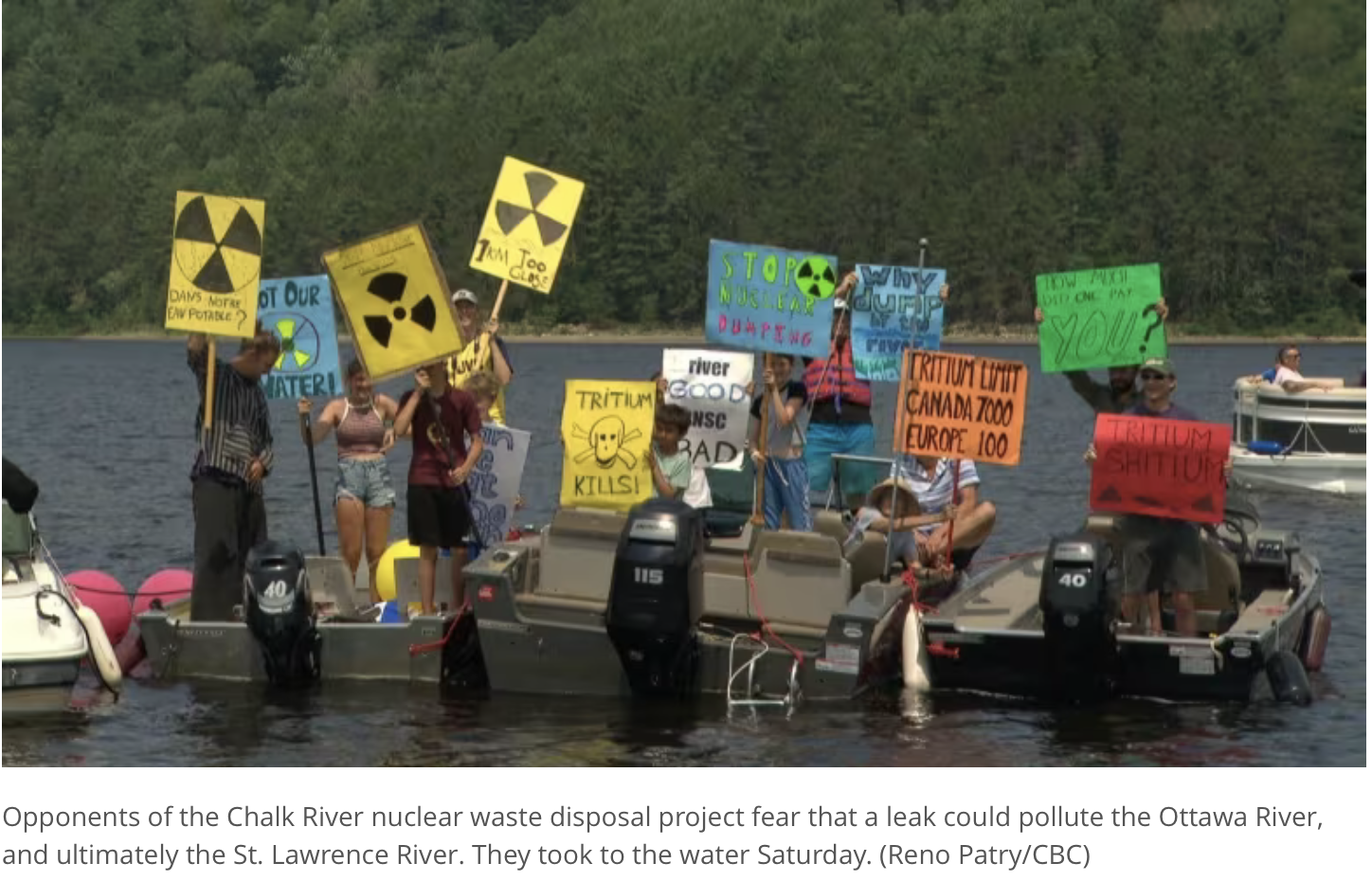By Cym Gomery, Montréal for a World BEYOND War, July 8, 2024
If you live in Canada, you should be alarmed. If you live in Ontario, you should be terrified.
In January 2024, the Canadian government gave the Canadian nuclear safety commission (CNSC), a consortium of multinational corporations, the green light to build a nuclear waste megadump, euphemistically called a Near Surface Disposal Facility (NSDF), at the Chalk river site near the Ottawa river (known as Kichi Sibi in Algonquin), just upstream from the Saint-Lawrence.
This deadly landfill will be seven stories high and the size of 70 NHL hockey rinks. Nothing like it exists in Canada, and it will be the largest of its kind in the world. This glowing glob would hold five times as much radioactive waste as a controversial deep geologic repository on Lake Huron.
|
An unforeseen event – earthquake, deluge or explosion – could contaminate the Ottawa River and its riverbed from Chalk River to Montreal. Remember the Tsunami that caused the Fukushima nuclear plant in Japan to explode in 2015? Did you know that in January 2023 Fukushima began dumping radioactive waste into the Pacific ocean? No one can guarantee that a similar sequence of events could not occur here in Canada. The megadump project is opposed by all but one of the 11 Algonquin communities on whose unceded territory the nuclear waste is to be stored, for 500 years. We have no way of knowing what the human population (if alive) in 2523 will do with the waste at that point… presumably if humans have managed to survive that long it will be because they abandoned nuclear energy early on (in 2024 perhaps?) and found a way to store this legacy waste that does not compromise living rivers and the water we need in order to live. |
Originally, it was an atomic bomb project |
|
In 1944 the federal government expropriated the Chalk River site, which has belonged to the Algonquin Nation for thousands of years, for the World War II Atomic Bomb Project, without asking or notifying or compensating the Algonquins for whom the site had cultural and religious significance. Essentially, the government stole the land and used it to build weapons of mass destruction. |
A nearby reactor is already leaking |
|
The Nuclear Power Demonstration (or NPD) in Rolphton Ontario, not far from the Chalk river site, was the first Canadian nuclear power reactor, and the prototype for the CANDU reactor. Built by Canadian General Electric (now GE Canada), in partnership with Atomic Energy of Canada Limited (AECL) and Ontario Hydro (now Ontario Power Generation), it consisted of a single 22 MWe pressurized heavy water reactor (PHWR) unit. The NPD reactor now sits idle and one blogger writes: “Considering the Chalk River facility’s property is well known to have on-site leaking radioactive waste, and it was built AFTER the NPD facility; I can only imagine what kind of nuclear waste has been dumped and forgotten about in the forest around the NPD reactor.” |
Consultation timeline |
|
The Canadian government hired the Canadian nuclear safety commission (CNSC) in 2015 to “reduce the liability” associated with federally owned radioactive wastes, estimated to exceed $7 billion. Thus we can see from the beginning that the government’s concern was not human safety so much as profit. The CNSC acts as a convenient proxy for the government, providing a pseudo-official expertise while shielding the Trudeau government from criticism. In 2016, the CNSC launched an environmental assessment, and came up with the idea of creating a “megadump” one km from the Ottawa river, to hold about one million cubic metres of radioactive and nonradioactive toxic wastes in perpetuity. In 2017, the Assembly of First Nations accused the CNSC and the federal government of failing to meet their constitutional duty to consult and accommodate First Nations. Greenspace Alliance and the Ottawa Riverkeepers group participated in a parade in the fall of 2017 to draw attention to the danger of the planned megadump. Ottawa Riverkeepers member Meredith Brown explained, “We’re really concerned about the intermediate-level waste, because what they’re proposing for this — it’s really a landfill. It’s a landfill for hazardous waste. And those landfills are made to last up about 500 years, and intermediate level waste will last for thousands of years.” –To which Kurt Kehler, vice-president of decommissioning and waste management at Canadian Nuclear Laboratories, responded that the landfill would contain the “very lowest edge of intermediate-level waste” which is reassuring to those who can imagine being just a little bit dead. In 2018, dozens of mayors with the Montreal Metropolitan Community (CMM) unanimously adopted a motion to oppose the development of the megadump, and they have remained steadfast in their opposition. In 2019, protesters used boats to draw attention to their message about the potential dangers the dump presents for the health of the water. |
In 2020, Canada committed to review its radioactive waste policy, and nine months later, in 2021, Natural Resources Canada launched the review. Hundreds of civil society organizations, Indigenous peoples and concerned Canadians engaged with Natural Resources Canada, and thousands of Canadians called for a ban on reprocessing of nuclear waste.
In April 2023 Natural Resources Canada posted the final policy to a government website. Organizations who had participated in the policy development process between November 2020 and May 2022 were profoundly disappointed, calling the policy a handoff to the nuclear industry. “It is a fundamental failure. It leaves the industry in charge and the public and the environment at risk. This policy is a betrayal of science and public trust,” said Dr. Ole Hendrickson, for the Sierra Club Canada Foundation.
In summer of 2023, Ottawa civil society organizations called on Natural Resources Minister Jonathon Wilkinson to engage with Canadians on appropriate strategies for the management of radioactive waste rather than simply rubber stamping the nuclear industry’s recommended approach. On Thursday August 10, 2023, three Algonquin communities gave their final arguments to two members of the Canadian Nuclear Safety Commission (CNSC). Tellingly, both of these Commissioners had worked for many years for the nuclear industry.
|
The Algonquins were not allowed to present in person before the Commissioners, so they were forced to rent a hall for $8000 where chiefs, elders, councillors, researchers and lawyers from three Algonquin communities – Kebaowek First Nation, Kitigan Zibi Anishinabeg, and Barriere Lake First Nation – as well as their supporters–watched the presentations to the Commissioner by Zoom. There were numerous problems with the sound, requiring long pauses… When one considers this, the $8000 fee, and the very existence of a nuclear waste site on indigenous unceded land–it is hard not to conclude systemic racism. Many of the non-Indigenous representatives who came to hear the Algonquin Nations final arguments before the CNSC signed their names to a statement:”NO CONSENT, NO DUMP.” Nonetheless, in January 2024, the CNSC granted CNL permission to build the near surface disposal facility. |
Court challenge |
|
There are three major problems with the Canadian government’s plan to allow an NSDF at the Chalk River site.
The Kebaowek First Nation has requested a judicial review of the decision to allow the NSDF, based on the UN Declaration on the Rights of Indigenous Peoples (2007) and the United Nations Declaration Act (2021). There will be hearings on July 10 and 11 2024 in Ottawa, and Montreal for a World BEYOND War will be there for the press conference and the rally. |
Take action! |
|
Fortunately, there are many ways you can urge the government to rethink the NSDF project on Chalk River and advocate for the enforcement of the United Nations Declaration on the Rights of Indigenous Peoples (UNDRIP).
|










